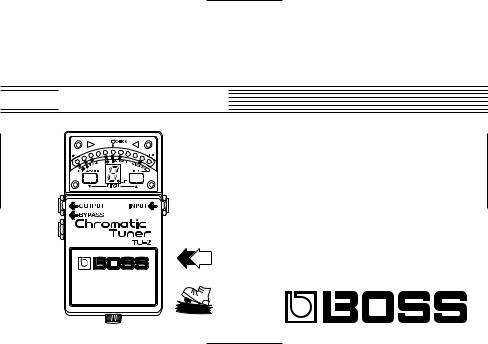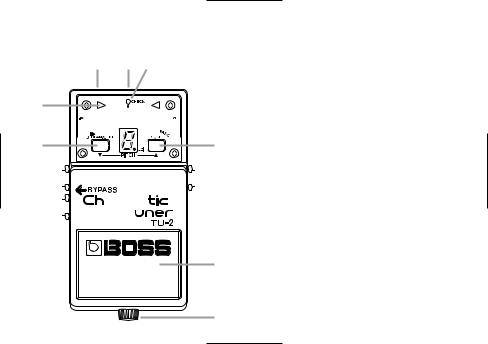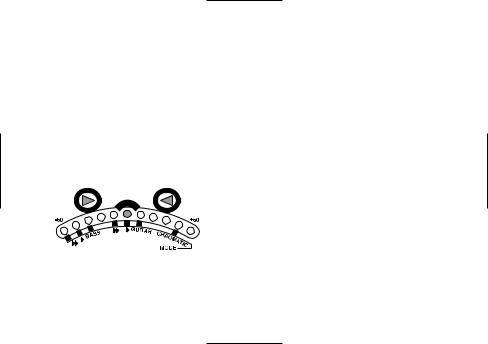Boss TU-2 User Manual [ru]

 Owner’s Manual
Owner’s Manual
AC DC
AC & BATTERY
POWERED
FET
1

Thank you, and congratulations on your choice of BOSS TU-2 Chromatic Tuner.
Before using this unit, carefully read the sections entitled: “USING THE UNIT SAFELY” and “IMPORTANT NOTES” (p. 28–34; 5–7). These sections provide important information concerning the proper operation of the unit. Additionally, in order to feel assured that you have gained a good grasp of every feature provided by your new unit, Owner’s manual should be read in its entirety. The manual should be saved and kept on hand as a convenient reference.
Copyright © 1998 BOSS CORPORATION
All rights reserved. No part of this publication may be reproduced in any form without the written permission of BOSS CORPORATION.
2

Features
•The ideal tuner for use in live concert situations.
•Since the TU-2 uses the same shape and structure as other Boss compact effect units, it features excellent durability and allows neat connection with other effect units.
•The OUTPUT is muted when the tuning function is on, allowing you to tune without being heard.
•High-luminosity LEDs allow visual tuning even in outdoor sunlight.
•You can choose from two types of meter display: CENT (normal needle-style movement), or STREAM (a flow of lights indicates the pitch deviation).
•In addition to chromatic mode which indicates the note name of the input sound, you can also use Guitar/Bass mode which displays the string number. (5-string bass is supported.)
3

•In Guitar/Bass mode, you can also use Flat tuning (a semitone down) or Doubleflat tuning (a whole step down).
•When the tuner is off, a battery conservation function minimizes power consumption.
•By using an AC adapter (sold separately) with the DC 9V in/out jacks, you can supply power to other compact effect units as well.
4

IMPORTANT NOTES
In addition to the items listed under “USING THE UNIT SAFELY” on page 28–34, please read and observe the following:
Power Supply: Use of Batteries
•Do not use this unit on the same power circuit with any device that will generate line noise (such as an electric motor or variable lighting system).
•The AC adaptor will begin to generate heat after long hours of consecutive use. This is normal, and is not a cause for concern.
•Batteries should always be installed or replaced before connecting any other devices. This way, you can prevent malfunction and/or damage to speakers or other devices.
•A battery was installed in the unit before it left the factory. The life of this battery may be limited, however, since its primary purpose was to enable testing.
•Before connecting this unit to other devices, turn off the power to all units. This will help prevent malfunctions and/or damage to speakers or other devices.
Placement
•Using the unit near power amplifiers (or other equipment containing large power transformers) may induce hum. To alleviate the problem, change the orientation of this unit; or move it farther away from the source of interference.
5

•This device may interfere with radio and television reception. Do not use this device in the vicinity of such receivers.
•Do not expose the unit to direct sunlight, place it near devices that radiate heat, leave it inside an enclosed vehicle, or otherwise subject it to temperature extremes. Excessive heat can deform or discolor the unit.
•To avoid possible breakdown, do not use the unit in a wet area, such as an area exposed to rain or other moisture.
Maintenance
•For everyday cleaning wipe the unit with a soft, dry cloth or one that has been slightly dampened with water. To remove stubborn dirt, use a cloth impregnated with a mild, non-abrasive detergent. Afterwards, be sure to wipe the unit thoroughly with a soft, dry cloth.
•Never use benzine, thinners, alcohol or solvents of any kind, to avoid the possibility of discoloration and/or deformation.
Additional Precautions
•Use a reasonable amount of care when using the unit’s buttons, sliders, or other controls; and when using its jacks and connectors. Rough handling can lead to malfunctions.
6

•Never strike or apply strong pressure to the display.
•When connecting / disconnecting all cables, grasp the connector itself—never pull on the cable. This way you will avoid causing shorts, or damage to the cable’s internal elements.
•To avoid disturbing your neighbors, try to keep the unit’s volume at reasonable levels. You may prefer to use headphones, so you do not need to be concerned about those around you (especially when it is late at night).
7

Panel Description
2 1 8
1. DC 9V In jack
An AC adapter (BOSS PSA series: sold separately) can be connected to this jack. If an AC adapter is used, you will be able to play for extended periods without worrying about battery life.
5
3
7
10









11







 4
4
6









 9
9
*As soon as you connect the AC adapter, the unit is turned ON.
2. DC 9V Out jack
When an AC adapter is used, you can connect a PCS-20A parallel DC cord (sold separately) to supply power to other PSA-adaptor-compatible devices.
*Power cannot be supplied when the TU-2 is running on batteries.
* There are two types of adaptors in the PSA series; they differ by the maximum amount of current that they are able to output (200 mA or 500 mA). If you're using the PCS-20A in combination with a PSA series adaptor, make sure that the total cur-
12 rent consumption of this unit and the PSA-adap- tor-compatible devices being supplied with power doesn't exceed the maximum output of the PSA series adaptor you're using (200 mA or 500
13 mA).
8

3. Meter
The meter indicates the pitch deviation of the input sound from the note name or string number that is shown in the note name / string number indicator.
CENT display
The LED that is lit will be further toward the left as the input pitch is flat, and further toward the right as the input pitch is sharp.
The pitch is correct when the center (green) indicator of the meter is lit.
STREAM display
Deviation of the input pitch will be shown by a flow of lights toward left or right.
The lights will flow toward the left if the input pitch is flat, and toward the right if the input pitch is sharp.
As the pitch deviation decreases, the flow will become slower, and the flow will stop when the pitch is correct.
4. Note name / String number indicator
In Chromatic mode, this indicates the note name.
In Guitar/Bass mode, this indicates the string number.
9

5. Tuning guide indicators
These will light to roughly indicate the tuning.
The pitch is flat
The pitch is sharp
The pitch is correct
(within +/-3 cents)
6. MODE select switch
This switch changes the tuning mode. When this switch is first pressed, the meter will blink to indicate the current mode.
If you press the switch again, the meter will cycle through the following modes, and the corresponding indicator will light.
Bass Double Flat |
|
Bass Flat |
|
Bass |
Chromatic |
Guitar
Guitar Flat
Guitar Double Flat
10

7. STREAM/CENT select switch
This switches the meter display method. The meter will indicate the selected display method for approximately two seconds after the method has been switched.
8. CHECK indicator
This shows the Tuner On/Off status and also serves as a battery check indicator.
This indicator will light when the tuner is on. If the indicator is dim or fails to light when the tuner is on, the battery has run down, and should be replaced with a new battery as soon as possible. For the procedure, refer to “Changing the battery” (page 23).
*The CHECK indicator shows whether the effect is being applied or not. It does not indicate whether the power to the device is on or not.
9. INPUT jack
Use this jack to connect the electric guitar / electric bass that you wish to tune.
*When a battery is used, the input jack also functions as a power switch. When a plug is inserted into the input jack, the power will be turned on. When the plug is pulled out, the power will be turned off. When you are not using the tuner, pull the plug out of the input jack.
10. OUTPUT jack
Connect your amp or another effect unit to this jack.
When the tuner is off, this will output the signal of the instrument connected to the Input jack.
When the tuner is on, no sound will be output from this jack, so use this jack if you wish to tune silently.
11
